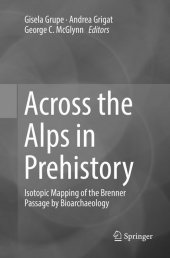 Neuerscheinungen 2018Stand: 2020-02-01 |
Schnellsuche
ISBN/Stichwort/Autor
|
Herderstraße 10
10625 Berlin
Tel.: 030 315 714 16
Fax 030 315 714 14
info@buchspektrum.de |

Andrea Grigat, Gisela Grupe, George C. McGlynn
(Beteiligte)
Across the Alps in Prehistory
Isotopic Mapping of the Brenner Passage by Bioarchaeology
Herausgegeben von Grupe, Gisela; Grigat, Andrea; McGlynn, George C.
Softcover reprint of the original 1st ed. 2017. 2018. xiv, 255 S. 67 SW-Abb., 6 Farbabb. 235 mm
Verlag/Jahr: SPRINGER, BERLIN; SPRINGER INTERNATIONAL PUBLISHING 2018
ISBN: 3-319-82381-7 (3319823817)
Neue ISBN: 978-3-319-82381-2 (9783319823812)
Preis und Lieferzeit: Bitte klicken
At the heart of this book is the matter of how isotopic landscapes combined with data mining enriches insights on prehistoric migration and cultural transfer. Isotopic mapping is an indispensable tool for the assessment of mobility and trade in the past, but is limited by eco-geographic redundancies. An interdisciplinary research group focuses on the archaeological isotopic landscape of a reference region of outstanding importance, namely the transalpine migration route via the Brenner Pass which has been in use since the Mesolithic. Over the period of several cultural epochs, cremation was either the most common or exclusive burial custom practiced. For the first time, a systematic and large scale investigation of cremated remains was being conducted in the field of prehistoric migration research. 87 Sr/ 86 Sr, 208 Pb/ 204 Pb, 207 Pb/ 204 Pb, 206 Pb/ 204 Pb, 208 Pb/ 207 Pb, 206 Pb/ 207 Pb and - if applicable - also d18O were measured in human and animal skeletal finds, an isotopic map was established, and innovative methods of data mining and similarity research have been applied to accomplish this novel approach to studying prehistoric migration and culture transfer. The book has interdisciplinary appeal and scholars working in bioarchaeology, physical anthropology and computer applications in life sciences will find it of particular interest.
1 Transalpine mobility and trade since the Mesolithic (Lang, Metzner-Nebelsick, Sommer, Steidl): Concepts of mobility and migration; State of the art; Open questions (which can potentially be solved by isotopic mapping).- 2 The concept of isotopic landscapes and isotopic mapping in bioarchaeological research (Grupe, Hölzl, Mayr, Söllner): Isotopic landscapes; Approaches to isotopic mapping for archaeology; Aims and scopes of this project.- 3 Isotopic mapping by use of archaeofaunal assemblages (Peters): Advantages and prerequisites; Accompanying insights into archaeozoology (domestication, trade, subsistence economy).- 4 Validation of isotopic data in bioapatite of cremated and uncremated archaeological finds (Schmahl): Bioapatite and its high temperature modifications; Diagenesis of bioapatite; Sample decontamination and mineralogical characterization; Catalogue of quality criteria for stable isotope analysis of bioapatite.- 5 The isotopic fingerprint: New methods of data mining and similarity search (Kriegel, Kröger): Uncertain data and how to cope with them; Definition of similarity; Dependent and independent variables; Definition of individual place of origin and probabilities.- 6 Isotopic map of the Inn-Eisack-Etsch-Brenner passage (Söllner, Grupe, Kröger): Definition and establishment of archaeological isoscapes; comparison with modern Isoscapes; Calculation and definition of local cut-off values; Comparison of conventional maps with those generated by computer scientists.- 7 Current synthesis and future options (whole research group): Application of the map to uncremated and cremated finds, interpretive potential, World wide data sharing


